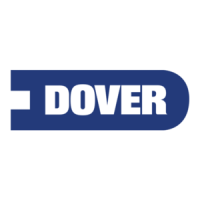9393PrincetonGlendaleRoad
Hamilton,Ohio45011
Revision1.2ROMIII“‐L”&“‐LIQ”Installation&OperationManualPageNo.13of15
7.4 Auxiliary Inputs
The AUXILIARY INPUTS are three independent intrinsically safe signal sources
connected to monitoring circuits. These inputs provide a voltage source that when
connected to the COM common terminals, will enable the auxiliary permissive circuit.
This, in addition to the normal overfill permissive circuit, controls the "PERMISSIVE"
state of the module. You must have BOTH circuits permissive before any external
permissive signals are given. Figure 2 shows the connections to Aux terminals, which
is to the left of TB2, the sensor connections. This figure also shows the auxiliary
devices as simple switches. Unused inputs MUST be connected to a COM common
terminal next to itself.
Please remember that these signals are intrinsically safe and cannot be run with any
other wires in a cable. Only the auxiliary wires and their commons can be run
together in a cable.
Any type of simple switch may be used as the switching device. These can be
pressure switches which connect to the airlines to indicate a pressurized line, or an
un-pressurized condition. The switch could also be a micro-switch to indicate the
position of something that moves. In all cases, this switching mechanism cannot be
accidentally connected to a NON-intrinsically safe voltage source. Because of this
low switching current requirement for intrinsically safe circuits, the contact material
on the switching mechanism should be GOLD plated. If corrosive contact materials
are used, then the integrity of the switched signal could be compromised, and not
work reliably all the time. If this contact plating is not available, then the best
possible material should be use, with every effort made to keep the corrosive
atmospheres out of the switching chamber of the device.
Which leads us to the next problem of corrosion, keeping the connections to the
wires free from corrosion. Boots, sealant, junction boxes, or any means must be
used to maintain the integrity of the connection to the switching device. The cables'
integrity to moisture must also be maintained with any exposed internal wires.
Sealing the ends of the cable jacket are suggested, unless the cable enters a
junction box that has strain relief fittings on it to keep the moisture outside of itself.
7.5 Sockets
Access openings are provided at the OBM so that each type of socket used may have
its own access connection only if the auxiliary inputs are not used. If the auxiliary
inputs are used, use the convention shown in Figure 1. It combines the Thermistor
and Float outputs into one cable exit. This convention is not required but will help in
troubleshooting and tracing the system output if a problem should occur. Cross
reference the CIVACON part number of the socket to its proper wiring diagram and
connect accordingly. Please use the CIVACON Instruction Sheet H50200PA, which is
packaged with each socket, for additional reference information on the sockets.
Strain reliefs are recommended for all cable entry locations. Note that pipe plugs are
required to be installed in all of the openings which are not used for cable entry. A
thread sealant is also recommended to be used with each strain relief or pipe plug.

